2024
A milestone year for Opto 22. Over the last 50 years, we've earned a reputation for: innovation in automation, USA-made products built to last, use of open standards and technology, personal attention to help you succeed, free training and product support, and guaranteed-for-life I/O. Celebrate with us!
2023
groov RIO had an important 3.5 firmware update. Opto 22’s already ground-breaking compact IIoT-ready device with software-configurable I/O now has CODESYS, an IEC61131-3 compliant programming environment with all your favorite languages. With this update, groov RIO is not only an I/O device—it's an Edge PLC.
2022
Power and energy monitoring come to the forefront again with the release of the groov RIO EMU energy monitoring unit and a power-monitoring input module for groov EPIC. Both modules help you gauge machine health, avoid downtime, and reduce costs by monitoring 3-phase power loads up to 600 VAC and securely sending data where you need it.
2020
The first model in Opto 22's new groov RIO® family of edge I/O devices was released in 2020. (Not even a pandemic can stop us!) The GRV-R7-MM1001-10 is a small-footprint, 10-channel, universal remote I/O unit. Web-based configuration and built-in capabilities like Power over Ethernet (PoE), MQTT communications, and Node-RED make groov RIO ideal for many IIoT and automation applications.
2018
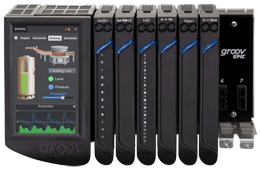 The year of an EPIC announcement. The world's first Edge Programmable Industrial Controller, called groov EPIC®, began shipping in May. groov EPIC is much more than a PLC or a PAC. We designed it from the ground up as both a reliable real-time industrial controller and a processor to collect, process, display, and exchange data. groov EPIC talks directly to field devices, other control systems, databases, cloud services, and a lot more. EPIC helps solve the challenges of complexity, security, and cost.
The year of an EPIC announcement. The world's first Edge Programmable Industrial Controller, called groov EPIC®, began shipping in May. groov EPIC is much more than a PLC or a PAC. We designed it from the ground up as both a reliable real-time industrial controller and a processor to collect, process, display, and exchange data. groov EPIC talks directly to field devices, other control systems, databases, cloud services, and a lot more. EPIC helps solve the challenges of complexity, security, and cost.
2017
With the addition of Ignition Edge® from Inductive Automation®, the groov Box became the groov Edge Appliance. Ignition Edge provides OPC-UA drivers plus MQTT/Sparkplug for efficient IoT communications, bringing visualization, data handling, and connectivity to the network’s edge—all in a compact, industrially hardened device.
2016
As Industrial Internet of Things (IIoT) applications begin to show real growth, we added new tools for developers and automation engineers. The goal: bridge the gap between existing industrial assets and the digital world of cloud computing and information technology.
 Because we believe that open standards offer the best automation, in 2016 we equipped our SNAP PAC controllers with a RESTful API (application program interface)—the first industrial PACs to offer an API. The PAC's RESTful API and https server give you secure access to control variable and I/O data in the PAC, using your programming language of choice.
Because we believe that open standards offer the best automation, in 2016 we equipped our SNAP PAC controllers with a RESTful API (application program interface)—the first industrial PACs to offer an API. The PAC's RESTful API and https server give you secure access to control variable and I/O data in the PAC, using your programming language of choice.
We also added Node-RED nodes for industrial PACs and groov View, and included Node-RED in the groov Box itself. An open-source tool for wiring together hardware devices, databases, cloud services, and APIs with simple logic flows, Node-RED offers pre-built nodes that make programming the IIoT easier.
 2016 also saw a fun product addition of Digital I/O for Raspberry Pi®. Today’s engineers are finding a Pi surprisingly useful in real industrial applications, as well as for prototyping and experimenting. Used with Opto 22's reliable industrial I/O, a Pi can safely switch 5-60 VDC, 120 VAC, and 240 VAC loads. You can even use Node-RED to quickly read and write I/O to build a Pi.
2016 also saw a fun product addition of Digital I/O for Raspberry Pi®. Today’s engineers are finding a Pi surprisingly useful in real industrial applications, as well as for prototyping and experimenting. Used with Opto 22's reliable industrial I/O, a Pi can safely switch 5-60 VDC, 120 VAC, and 240 VAC loads. You can even use Node-RED to quickly read and write I/O to build a Pi.
2014
 New analog input and output modules now integrate HART® (Highway Addressable Remote Transducer) communications with the SNAP PAC System. You can incorporate data from HART devices into your control applications just as you do the analog, digital, and serial I/O signals received from other SNAP I/O modules installed on the I/O rack. And using our groov mobile operator interface (introduced in 2013), you can display HART device and all other control system data on any mobile device.
New analog input and output modules now integrate HART® (Highway Addressable Remote Transducer) communications with the SNAP PAC System. You can incorporate data from HART devices into your control applications just as you do the analog, digital, and serial I/O signals received from other SNAP I/O modules installed on the I/O rack. And using our groov mobile operator interface (introduced in 2013), you can display HART device and all other control system data on any mobile device.
2013
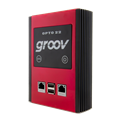 The year of groov. Mobile operator interface development took a leap into the future with the 2013 release of the first groov product for virtually all automation systems (industrial automation, building automaton, energy systems, and much more).
The year of groov. Mobile operator interface development took a leap into the future with the 2013 release of the first groov product for virtually all automation systems (industrial automation, building automaton, energy systems, and much more).
groov View was the first software in the automation space to make it simple to build mobile interfaces on any brand computer using a modern web browser and then use those interfaces on virtually any smartphone, tablet, laptop, PC—even a web-enabled HDTV. Because groov View is built on widely supported standards like OPC UA, HTML5, CSS3, and SVG, it provides the flexibility to put your system on your mobile™.
2012
An exciting start to 2012: Opto's contributions to explorer and filmmaker James Cameron's historic dive to the bottom of the Mariana Trench, the deepest spot in the ocean. Cameron's high-tech submersible relied on an off-the-shelf SNAP PAC System for more than 180 onboard systems—including depth sensors, batteries, thrusters, 3D cameras, lighting, and life support.
 Also in 2012, the software-based programmable automation controller SoftPAC offered a new option in controllers. Programmed with the same software and in the same way as a SNAP PAC controller, SoftPAC lets you choose to run your control program on an embedded or standalone PC, for PC-based control.
Also in 2012, the software-based programmable automation controller SoftPAC offered a new option in controllers. Programmed with the same software and in the same way as a SNAP PAC controller, SoftPAC lets you choose to run your control program on an embedded or standalone PC, for PC-based control.
2011
 New products in 2011 focused on mobility and energy.
New products in 2011 focused on mobility and energy.
The Opto iPAC app brought automation into the 21st century with instant access to Opto 22 control variables and I/O points from a mobile device. First released for iPhone, iPod touch, and iPad, Opto iPAC was followed in 2012 by Opto aPAC for Android smart phones and tablets.
Opto 22 also released the OptoEMU Sensor energy-monitoring unit. Building on the success of SNAP power monitoring modules but packaged as an appliance, the OptoEMU Sensor simplified energy monitoring for commercial and industrial businesses.
2009
Wireless was the big news in 2009. Opto 22 added wireless capability to SNAP PAC controllers and brains in ways no other manufacturer had done to date: offering both wired and wireless networking in the same hardware, supporting a broad range of wireless standards, and making the full line of SNAP I/O usable in both wired and wireless networks without special adapters.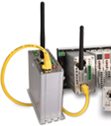
2008
2008 saw the introduction of intelligent remote SNAP I/O for Allen-Bradley PLC systems. SNAP I/O's distributed intelligence makes it possible to extend A-B systems easily, without programming.
Also introduced in 2008, the SNAP TEX line of breakout boards, cables, and other accessories added convenience to field wiring.
By 2008 the Opto 22 website featured a number of videos—case studies, product overviews, and how-to videos—which helped customers learn how to choose and use Opto products.
2007
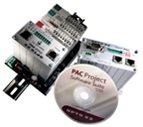 The year 2007 saw the introduction of the SNAP PAC System, an integrated system of hardware and software designed to simplify the typically complex process of understanding, selecting, buying, and applying an automation system. Just four components—software, controllers, brains, and I/O—make up this easy-to-spec and easy-to-use system, suitable for applications from simple monitoring to automating an entire factory.
The year 2007 saw the introduction of the SNAP PAC System, an integrated system of hardware and software designed to simplify the typically complex process of understanding, selecting, buying, and applying an automation system. Just four components—software, controllers, brains, and I/O—make up this easy-to-spec and easy-to-use system, suitable for applications from simple monitoring to automating an entire factory.
2006
In late 2005 and early 2006, Opto 22 introduced SNAP PAC programmable automation controllers. Completely integrated with PAC Project control, HMI, and OPC server software, these powerful industrial controllers included two independent Ethernet network interfaces.
2005
 New high-density digital SNAP I/O modules offered 32 digital points in the space that four used to occupy, for a possible total of 512 digital points on one rack.
New high-density digital SNAP I/O modules offered 32 digital points in the space that four used to occupy, for a possible total of 512 digital points on one rack.
2005 also brought new opportunities for older Optomux systems: the E1 and E2 brain boards support Optomux over both serial and Ethernet networks, as well as additional protocols including Modbus/TCP and OptoMMP, our memory-mapped protocol also used by SNAP Ethernet-based I/O units.
2004
In 2004, Opto 22 introduced the SNAP OEM I/O product family. The first product available in this new family, the SNAP-ARL-ASDS brain, premiered as a highly programmable, Linux-based I/O processor for OEMs, IT professionals, and others seeking to develop and use custom software applications to interface with SNAP I/O modules.
2003
Opto 22 continued its focus on developing solutions for machine-to-machine (M2M) applications by forging a partnership with Dallas-based SensorLogic. The two companies worked to simplify M2M application development and reduce the lead-time, cost, and technical risk in developing these applications.
Also introduced in 2003 was the OptoTerminal-G75, a large screen, graphics-based operator interface for use with the company’s Ethernet-based SNAP Ultimate I/O, SNAP Ethernet I/O, and SNAP-IT systems.
2002
Opto 22 forged technical and marketing partnerships with the world's leading mobile phone manufacturer, Nokia, and one of the largest wireless service providers, AT&T Wireless, to make it easier to assemble the components of an M2M system.
2001
The introduction of the powerful SNAP Ultimate brain led off 2001. Based on field-proven SNAP Ethernet I/O technology, SNAP Ultimate I/O added programmability, networking capability, and enterprise connectivity to the I/O level itself.
2000
The highlight of 2000 was the successful introduction of the SNAP-IT family of packaged products, designed for specific customer remote monitoring and machine-to-machine (M2M) applications. SNAP-IT units link remote assets such as communications towers to enterprise management software such as Computer Associates' Unicenter® TNG®.
1999
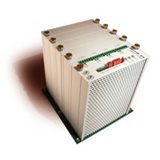 SNAP serial modules, introduced in 1999, expanded SNAP Ethernet systems to become the first to offer customers an industrial input/output system that can connect to virtually any plant-floor or real-world device.
SNAP serial modules, introduced in 1999, expanded SNAP Ethernet systems to become the first to offer customers an industrial input/output system that can connect to virtually any plant-floor or real-world device.
The workhorse SNAP-LCM4 was also introduced in 1999. This standalone industrial controller combined analog and digital control, serial communications, math processing, networking, and distributed I/O processing into a single, easy-to-implement environment. The M4SENET-100 Ethernet network interface card linked the SNAP-LCM4 with standard Ethernet networks, so that a separate I/O or control network was no longer required for the control system.
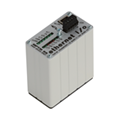 1998
1998
1998 saw the introduction of SNAP Ethernet I/O, the first Ethernet-based I/O unit. The award-winning, high-performance SNAP Ethernet brain connects Opto 22 I/O hardware components using any standard TCP/IP Ethernet connection.
1996
SNAP I/O in 1996 introduced a new form factor that reduced the I/O footprint by 60 percent and included standard fuses, pluggable field connectors, and versatile DIN-rail and panel-mounting capabilities with a snap-together design. A universal I/O processor allowed any combination of digital and analog modules to share the same rack. Both intelligent and software-configurable, SNAP analog proved ideal for OEM solutions.
Opto 22's new FactoryFloor software suite introduced OptoControl, a graphical, flowchart-based development environment; OptoDisplay, a graphical, multimedia operator interface; and OptoServer, a robust data server. OptoConnect (added later in the year) also provided bidirectional data flow between networked controllers and the rest of the enterprise.
1993
The introduction of the Mistic MMI (man-machine interface) in 1993 provided a Microsoft Windows-based graphical interface to the mistic control system. The Mistic MMI was fully integrated with Cyrano®, down to the database level, and featured point-and-click connection to real-time control data. The Opto 22 mistic system, with its new MMI, represented the first integrated control solution for manufacturing.
1991
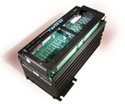 In 1991, mistic™, the first complete PC-based control system from a single source, combined Cyrano software, powerful 32-bit controllers, the new mistic protocol, and a revolutionary multi-function I/O system with software-selectable features. Mistic also represented a quantum leap forward in distributed intelligence, incorporating onboard PID and event reactions, high-speed counting, temperature conversions, and engineering unit support at the I/O level.
In 1991, mistic™, the first complete PC-based control system from a single source, combined Cyrano software, powerful 32-bit controllers, the new mistic protocol, and a revolutionary multi-function I/O system with software-selectable features. Mistic also represented a quantum leap forward in distributed intelligence, incorporating onboard PID and event reactions, high-speed counting, temperature conversions, and engineering unit support at the I/O level.
1988
Cyrano, the first graphical flowchart-based development environment for the PC, was introduced in 1988. Cyrano allowed real-time programs to be created by simply drawing flowcharts. These charts were then compiled and downloaded to Opto 22 controllers for real-time multitasking and distributed control. Cyrano provided a viable user-friendly alternative to the then-standard and cumbersome relay ladder logic programming model.
1985
Opto 22's line of local controllers, introduced in 1985, were small, rugged, diskless industrial single-board computers. The local controller allowed programs developed on the PC to be executed on the factory floor prior to the acceptance of PCs as a reliable industrial platform.
1983
In 1983, Opto 22 introduced PC-based control with a complete line of drivers and adapter cards for the PC. This facilitated the development of the first control applications using compiled and interpreted PC-based programming languages, and established the foundation for the PC-based control and data acquisition markets that are predominant today.
Also in 1983, Opto 22 created the first optically isolated analog I/O modules with intelligent racks, marking the beginning of a new era in computer-based automation.
1982
Optomux®, the first intelligent, serially addressable I/O system, using a simple open ASCII protocol, was introduced in 1982. The Optomux protocol soon became an industry standard for the distributed intelligent I/O market. Optomux allowed thousands of points of I/O to be distributed anywhere along a mile-long serial communications link. Processor-intensive tasks, such as counting and latching, were off-loaded to the individual I/O racks. This advance made system performance independent of the number of I/O points.
1981
In 1981, Opto 22 introduced Pamux®, the first addressable, expandable, computer-based I/O system. Pamux was capable of multiplexing hundreds of points of digital I/O from a single microprocessor parallel port. The extremely high-speed read and write capabilities of Pamux, coupled with the increased performance of microprocessors, enabled the use of computer-based control in large system-oriented applications.
1978
 In 1978, Opto 22 created the first generation of digital I/O modules with plug-in racks for microprocessor-based control. This quickly became the world standard form factor for I/O and created the component market for computer-based I/O. The red-black-yellow-white color-coding scheme Opto 22 designed remains the standard today.
In 1978, Opto 22 created the first generation of digital I/O modules with plug-in racks for microprocessor-based control. This quickly became the world standard form factor for I/O and created the component market for computer-based I/O. The red-black-yellow-white color-coding scheme Opto 22 designed remains the standard today.
1974
In 1974, Opto 22 introduced a complete line of optically isolated solid-state relays (SSRs) for the Component OEM market. The manufacturing technique, developed by Opto 22, used liquid epoxy fill and greatly increased the reliability and reduced the cost of volume production. Opto 22 quickly became, and remains today, the world's leading manufacturer of SSRs.